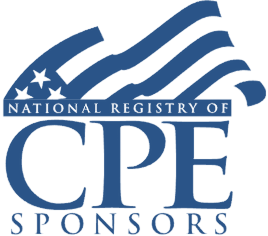Welcome! Save 30% on all CLE, CPE, and Professional Skills webinars, plus 15% off any annual pass with code HOLIDAY25
About the Course
Introduction
This webinar will review the nuances and calculations of single sales factor apportionment. Our panel of state income tax consultants will explain differences in market-based sourcing and cost of performance, outline the impact of the sales factor on the disposition of a business, and point out variances in states' application of single sales factor apportionment to avoid unexpected tax and minimize overall state tax paid by multistate companies.
Description
Multistate businesses must apportion income in the states where they have nexus. Earlier states often used a three-factor apportionment method, including sales, payroll, and property. Now, more than 30 states use single sales factor apportionment to determine taxable income within their state. Most recently, Montana and Vermont have joined these states, beginning in 2025 and 2023, respectively. At first glance, these calculations appear simple, with businesses paying tax on the percentage of income generated in each state; however, the nuances of these calculations are complex.
Most states that utilize single sales factor apportionment use market-based sourcing, dividing income based on the location of the customer receiving the benefit. However, many of these states still use the three-factor apportionment method. Adding to this complication, in New York, service businesses that are C and S corporations must use market-based sourcing, while partnerships and LLCs must use the three-factor method. Virginia has historically used the three-factor apportionment method, with double-weighted sales, but, beginning Jan. 1, 2023, will allow retailers to elect to use single-factor apportionment for consolidated retail groups that include other types of entities.
Listen as our panel of SALT technical experts explains the critical considerations of single sales factor apportionment in particular states and by business type. These calculations have a dramatic impact on taxes paid by multistate businesses. SALT practitioners working with these taxpayers need to understand the intricacies of these rules.
Presented By

Mr. Smith is national technical leader of BDO’s State & Local Tax (SALT) practice. He sets BDO's policies and positions on technical SALT issues, as well as thought leadership, brand visibility, training and risk management. Mr. Smith's SALT practice is the result of over 25 years of experience and is national in scope and focused on multistate tax consulting, representing clients in multistate SALT controversies, and advising clients with respect to their multistate tax planning. The main concentration of Mr. Smith's SALT practice is on corporate income and franchise taxes, but he has also advised and represented clients with respect to their sales and transactions tax needs as well. A significant amount of his representation focuses on helping clients on the state tax consequences of mergers and acquisitions, intra-group reorganizations, special purpose entities, and business planning.

Mr. Spengler's main area of focus is state income and franchise taxes with significant experience in the design and implementation of legal entity structures that are more tax efficient. As a result of his unique background, he has had success in designing structures that both minimize the impact on his client’s operations while maximizing the tax savings received by the client. Mr. Spengler specializes in the design of structures that both complement the client’s underlying business and provide diversified tax savings. As such, he has successfully designed structures for clients that simultaneously reduce state income tax, Single Business Tax, franchise tax, sales & use tax and federal income tax while logically fitting within the way the business operates. In addition to restructuring work, Mr. Spengler also has significant experience with the analysis of tax return positions and with the subtle interaction between the Federal income tax framework and its impact on a client’s state income tax reporting. He has had a great deal of success with securing significant refunds for clients related to gray and misunderstood areas of the tax law.
-
BARBRI is a NASBA CPE sponsor and this 110-minute webinar is accredited for 2.0 CPE credits.
Date + Time
- event
Thursday, June 22, 2023
- schedule
1:00 p.m. ET./10:00 a.m. PT
- Single sales factor apportionment: introduction
- Compared to other methods
- Three-factor vs. single sales factor apportionment
- Cost of performance vs. market-based sourcing
- Other trends
- Impact on disposition of a business or business assets
- Caveats
- State methodology differences
- Treatment differences by partner type
- Other caveats
- States requiring elections to use single sales factor
- Examples
- Specific states
- Specific business types
The panel will review these and other critical issues:
- States requiring elections to use single factor sales apportionment
- Impact of the sales factor on business and asset sales
- Specific state methodology differences in the application of single sales factor apportionment
- Differences in cost of performance and market-based sourcing
Learning Objectives
After completing this course, you will be able to:
- Determine how revenue from business sales impacts single sales factor apportionment in specific states
- Identify state nuances in the application of single factor sales apportionment
- Ascertain differences in cost of performance and market-based sourcing
- Decide which states require elections to use single factor sales apportionment
- Field of Study: Taxes
- Level of Knowledge: Intermediate
- Advance Preparation: None
- Teaching Method: Seminar/Lecture
- Delivery Method: Group-Internet (via computer)
- Attendance Monitoring Method: Attendance is monitored electronically via a participant's PIN and through a series of attendance verification prompts displayed throughout the program
- Prerequisite: Three years+ business or public firm experience preparing complex tax forms and schedules, supervising other preparers or accountants. Specific knowledge and understanding of SALT taxation, nexus and apportionment as it applies to multi-state businesses.

BARBRI, Inc. is registered with the National Association of State Boards of Accountancy (NASBA) as a sponsor of continuing professional education on the National Registry of CPE Sponsors. State boards of Accountancy have final authority on the acceptance of individual courses for CPE Credits. Complaints regarding registered sponsons may be submitted to NASBA through its website: www.nasbaregistry.org.

BARBRI CE webinars-powered by Barbri-are backed by our 100% unconditional money-back guarantee: If you are not satisfied with any of our products, simply let us know and get a full refund. Contact us at 1-800-926-7926 .
Unlimited access to premium CLE courses:
- Annual access
- Available live and on-demand
- Best for attorneys and legal professionals
Unlimited access to premium CPE courses.:
- Annual access
- Available live and on-demand
- Best for CPAs and tax professionals
Unlimited access to premium CLE, CPE, Professional Skills and Practice-Ready courses.:
- Annual access
- Available live and on-demand
- Best for legal, accounting, and tax professionals
Unlimited access to Professional Skills and Practice-Ready courses:
- Annual access
- Available on-demand
- Best for new attorneys
Related Courses

State Tax Strategies for Athletes and Entertainers: Residency and SALT Deduction Limitations
Tuesday, January 6, 2026
1:00 p.m. ET./10:00 a.m. PT



